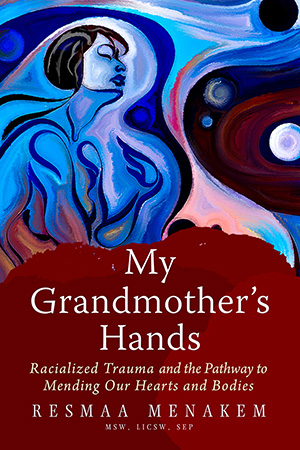Preached in Zoom Service, St. Augustine’s Episcopal Church, Wilmette, IL.
Fifth Sunday after Pentecost. Year A. July 5, 2020
Text: Romans 7:15-25a
I haven’t given a sermon since before COVID-19 made us go into Zoom church. So this is my first experience of preaching to virtual images on my computer screen. I trust that there are real people behind these images and that through the wonders of the internet this message will get through to you who are listening and watching the virtual image of me. I swear, I’m a real living body behind my image on your screen.
It’s about bodies, isn’t it? Normally we don’t think about our bodies, as long as they keep functioning like a well-oiled machine. We focus on the world around us. Our bodies enable us to do that because all five of our sense organs are on the exterior of the body, taking in what the world offers and sending messages through the nervous system to the brain for analysis.
For the past four or five months, what we have perceived from the outside world has made us very conscious of our bodies. We worry about the new coronavirus breaking through our immune system and making us sick, even sick unto death. So we wear masks and maintain our social distance, as we have been instructed to do.
But since the asphyxiation of George Floyd by a police knee on his carotid artery, shutting off the blood carrying oxygen to his brain, and before that the murder of Ahmaud Arbery in Georgia, who had been hunted down by three white men in two pickup trucks, and the gunning down of Breonna Taylor in her own bedroom by police officers who busted into her apartment unannounced – and by mistake, and now the emerging details about the violent takedown of 5’6” 140 pound 23-year old violinist and massage therapist Elijah McCrain by three police officers in Aurora, Colorado a year ago because someone reported a suspicious person walking down the street wearing a ski mask and waving his arms, a young man who even pleaded with the officers that he was an introvert, who was rendered unconscious twice by a carotid hold, and tranquilized by an injection of ketamine by first responders to come and suffered cardiac arrest on the way to the hospital, — all this and more awareness of dead Black bodies has also entered our consciousness. In the light of all this death swirling around us, the semi-final verse in today’s Second Reading leaps off the screen at us: “Wretched man that I am! Who will rescue me from this body of death?”
St. Paul isn’t talking here about the death of the body, which comes inevitably to every son and daughter of Adam and Eve. He’s talking about the body of death that comes from all the deadly stuff our flesh admits into our bodies.
Now I’ve got to say something about two words that St. Paul uses in this text. “Body” is soma. It’s our biological body that interacts with our natural environment to allow us to flourish as living beings. It’s what God created and pronounced “very good.” “Flesh” is sarx. This is harder to define, because it has several meanings even in the Greek Bible. It can refer to the body, understood as substance. ”Unless you eat the flesh of the Son of Man… you have no life in you” (John 6:53). Or it can refer to our mortal nature. “All flesh is grass… The grass withers, the flower fades…” (Isaiah 40:6-7). But for St. Paul “flesh” it is the willing instrument of sin. It’s what I take into my body from experiences in my interactions with the world, what gives me pain or pleasure, my appropriation of society’s norms, what I’ve learned in my cultural upbringing.
Today’s reading follows from St. Paul discussion of the law of God, which he says is good and holy, which expresses God’s will for us. But just so it exposes all this fleshly stuff as sin, and says that I’m captive to it. The struggle between doing what the law requires, and what I might even want to do, but don’t do, and what my flesh desires, and which I don’t want to do, but do anyway, is an internal struggle for each of us. It’s a kind of law in itself, says St. Paul, “that when I want to do what is good, evil lies close at hand.” It is so close at hand that it’s actually embodied in us. It is our flesh, which has its desires and its aversions.
The prayer of confession of sins for Morning and Evening Prayer in the old Book of Common Prayer, put this human predicament on our own lips. “We have left undone those things which we ought to have done [sins of omission]; And we have done those things which we ought not to have done [sins of commission]; And there is no health in us.” The word “health,” from the Latin salvus, is the same as salvation. We cannot save ourselves from this body of death.
I would propose that what the new consciousness about racism in our society exposes is an evil close at hand, even within our bodies.
I said that our brain analyzes what the senses report. But the brain has a receptionist. Stuff from the senses has to get past the receptionist to get to the analytical part of the brain. That receptionist is oldest part of our brain, the reptilian brain. Some call it the lizard brain. It receives information from the outside world through the vagus nerve that actually runs from the brain stem down to our gut. This receptionist can only make four decisions. In response to the sensory information: do we rest easy? (Just ignore it.) Do we fight? (We can take it on.) Do we flee? (It’s too big for us to handle.) Or do we freeze? (We’re trapped. Maybe it will just go away). These are called “gut reactions” because of the vagus nerve. The brain stem can pass its recommendations up to the cerebral cortex, which can analyze the situation. But in a tense situation, the lizard brain only wants to know if it’s dangerous or safe.
If you’re alone on a quiet street in Wilmette and you see an unknown 6’4” Black man coming down the sidewalk, how do you react? Do you momentarily tense up? Does the message go to the cerebral cortex, asking “Does he belong here?”
If you’re a Black man and you’re driving to the store to pick up groceries and you see a police car behind you, how do you react? Do you tense up? Does the message go to brain, “Oh, God, I hope my tail light isn’t out.”
If you’re a police officer and you see some Black youths standing around on a street corner, how do you react? Do you tense up? Does the message go to your brain, “Maybe these gang members might know something about the shooting last night?”
An author who get into all this in depth is Resmaa Menakem, in My Grandmother’s Hands: Racialized Trauma and the Pathway to Mending Our Hearts and Bodies. This book by an African American licensed clinical social worker, who does a lot of body-related therapy, examines white body supremacy in America, the traumas that produced our embodied racism, and the effect of this white trauma on Black bodies and blue bodies (the police). Let me give you a few summary statements from the book (page 36).

“Whether or not white body supremacy is formally and explicitly taught to us, it’s in the air we breathe, the culture we share, and the bodies we inhabit.”
Menakem suggests that white immigrants brought with them to America the traumas they had experienced for centuries in Europe and passed them down genetically. Do you know the stories of your immigrant ancestors? Consider that no one left a country behind because they were so happy with the conditions there. What traumas did they embody and bring with them to pass along to their descendants? How do these traumas get acted out against Blacks, Native Americans, and others as whites cling to all their privileges in the new land? How does what supremacy get integrated into Black bodies?
Menakem continues: “Because of white body supremacy, here’s how white, Black, and police bodies see each other:
“The white body sees itself as fragile and vulnerable, and it looks to police bodies for safety and protection. It sees Black bodies as dangerous and needing to be controlled, yet also as potential sources of comfort and service.
“The Black body sees the white body as privileged, controlling, and dangerous. It is conflicted about the police body, which it sees as sometimes a source of protection, sometimes a source of danger, and sometimes both at once.
“The police body sees Black bodies as often dangerous and disruptive, as well as superhumanly powerful and impervious to pain.” Is this why they think Black bodies have to be taken down so violently?
“There is a way out of all this,” writes Menakem. “It begins with your body.” And St. Paul agrees. This is the kind of deadly stuff of the flesh that we absorb into our bodies so that they become bodies of death. To his question, “Who will rescue me from this body of death?” he answers: “Thanks be to God, through Jesus Christ our Lord.”
As a result of the racial traumas of the last several months, we may hopefully see some changes this time in policing and police-community relationships and maybe some new laws and more social services. But as Menakem suggests, there’s a lot in our bodies that needs to be worked on in order to heal racism. We may think rationally, “I’m not a racist.” Our body says differently.
We Christians we are not resourceless in this. This text today is in the middle of a tightly-packed theological treatise. We already heard in Chapter 6 that our old selves have been put to death by our baptism into the death and resurrection of Christ. In Chapter 8, which we will read over the next three weeks, we will hear about the Holy Spirit working in our lives, “since the Spirit of God dwells in you.” Our baptism into Christ puts us squarely into this struggle between the flesh and the Spirit. But through hearing the gospel of Christ, receiving Holy Communion as one community in Christ of all races, genders, and ages, and practicing confession and forgiveness regularly, the mind of Christ takes hold in us and begins to counter the decisions our lizard brain. So when we see a large Black man coming down the street, the mind of Christ in us doesn’t ask, “Am I safe?” It says, “Oh, that’s my neighbor.”
“Who will deliver us from this body of death? Thanks be to God, through Jesus Christ our Lord.” Amen.
Frank C. Senn
Evanston, IL


